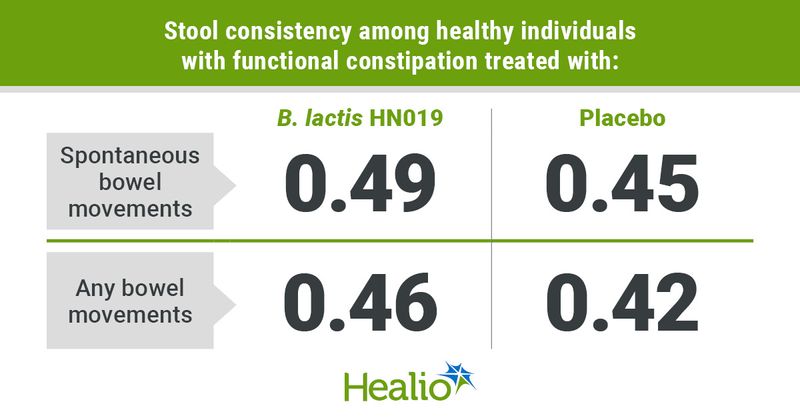No difference in stool frequency with B. lactis HN019 vs. placebo in constipation
Key takeaways:
- Healthy volunteers were assigned B. lactis HN019 at 4.69 × 109 CFU or placebo for 8 weeks.
- Complete spontaneous bowel movements per week increased from 0.73 to 1.58 with HN019 vs. 0.81 to 1.5 with placebo.
Daily consumption of Bifidobacterium animalis subsp lactis HN019 did not increase complete spontaneous bowel movements per week vs. placebo in healthy individuals with functional constipation, according to a study in JAMA Network Open.
“Bifidobacterium animalis subsp lactis HN019 (HN019) has been shown to improve constipation and gastrointestinal tract symptoms in adults at doses ranging from 1 × 109 to 17.2 × 109 colony-forming units (CFU) per day for 2 to 4 weeks,” Jing Cheng, PhD, of the department of health at International Flavors & Fragrances in Kantvik, Finland, and colleagues wrote. “Nevertheless, no studies have been performed using HN019 for functional constipation treatment with bowel movement frequency as primary outcome.”

In a randomized, triple-blind trial conducted at five hospitals in China, Cheng and colleagues investigated the effect of HN019 on complete spontaneous bowel movements (CSBMs) among 229 healthy volunteers (median age, 45 years; 84.7% women; mean BMI, 22.8 kg/m2) with Rome III functional constipation. At baseline, the group had a mean CSBM of 0.77 per week.
The trial consisted of a 2-week run-in period followed by 8 weeks of intervention, with participants randomly assigned to daily HN019 in maltodextrin at 7 × 109 CFU at the baseline visit and 4.69 × 109 CFU at the last visit (n = 112) or once-daily maltodextrin placebo (n = 117).
Secondary outcomes included use of rescue medication, stool consistency measured using the Bristol Stool Scale, degree of straining, abdominal pain and bloating.
According to results, mean CSBMs per week increased from 0.73 to 1.58 in the HN019 group and 0.81 to 1.5 in the placebo group, which was not a statistically significant difference between groups (least-square mean change = 0.8; 95% CI, 0.54-1.05 and 0.66; 95% CI, 0.41-0.9, respectively).
The researchers reported similar results between groups for both spontaneous bowel movements (0.49; 95% CI, 0.25-0.74 vs. 0.45; 95% CI, 0.21-0.68) or any bowel movements (0.46; 95% CI, 0.21-0.7 vs. 0.42; 95% CI, 0.18-0.65).
Results also demonstrated a slight increase in mean Bristol Stool Scale score for both groups, although this was less pronounced in the HN019 group (3.2 to 3.43 vs. 3.1 to 3.71). Abdominal pain and bloating increased slightly in the placebo group, which was not observed in the HN019 group, with the researchers reporting a “significant change” in abdominal pain favoring the probiotic at weeks 6 (–1.57; 95% CI, –2.95 to –0.19) and 8 (–1.46; 95% CI, –2.84 to –0.07).
Both groups experienced slightly less straining by the end of the study, although the change from baseline did not differ significantly between groups.
“In this randomized clinical trial, B. lactis HN019 did not increase CSBMs per week more than placebo,” Cheng and colleagues wrote. “Daily consumption of B. lactis HN019 at the tested dose of 4.69 × 109 CFU did not outperform placebo to increase CSBMs.”

